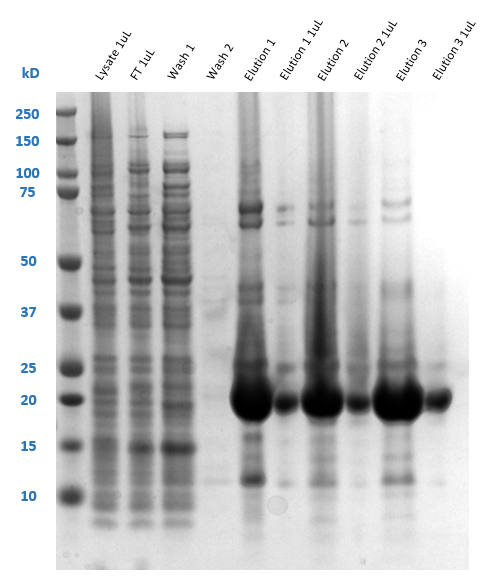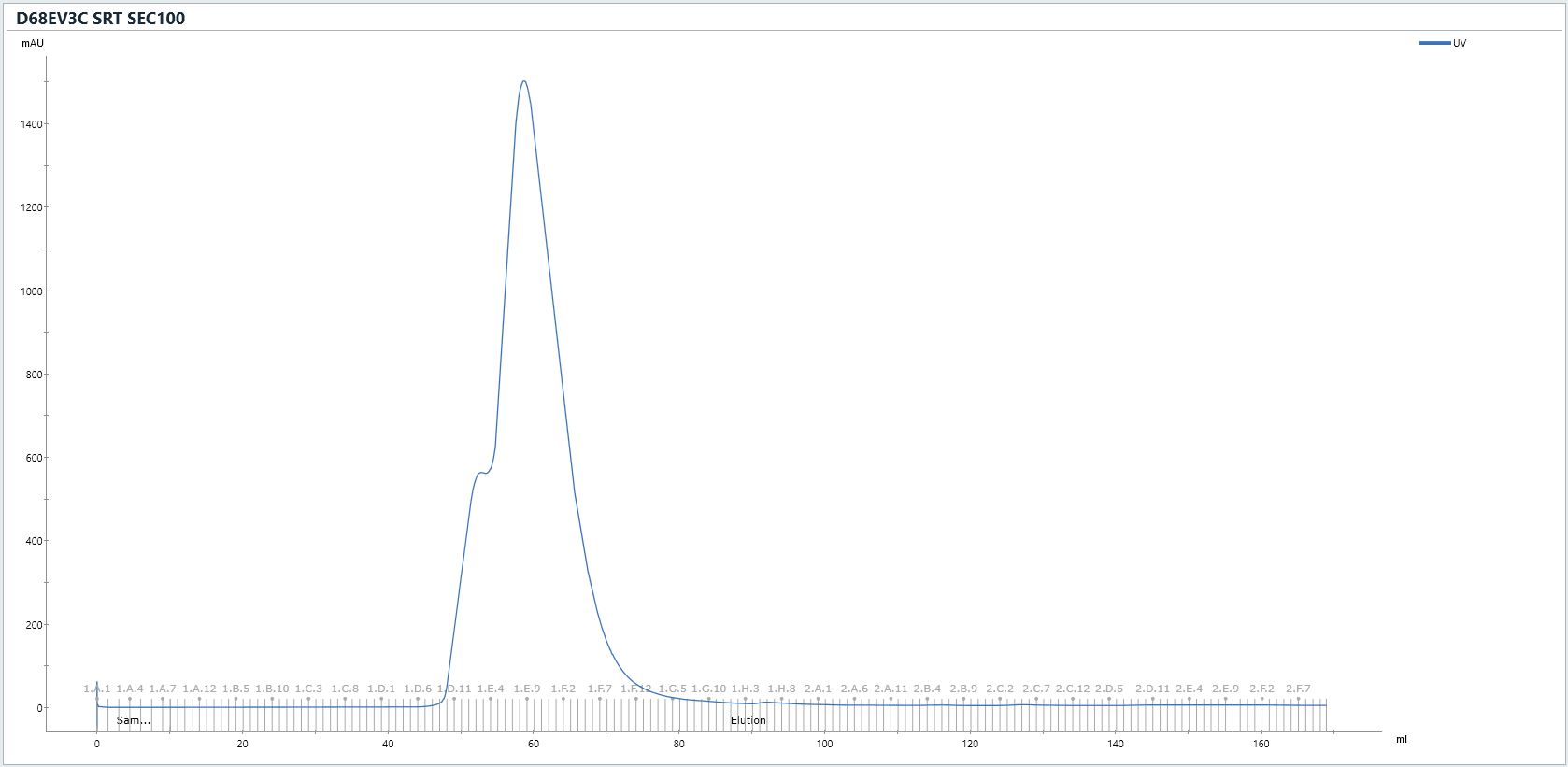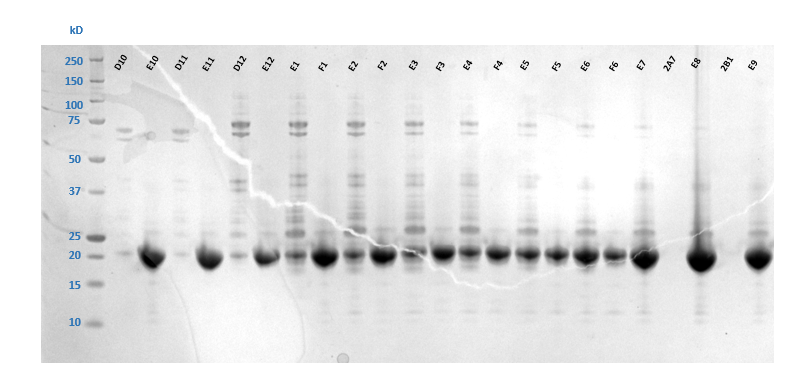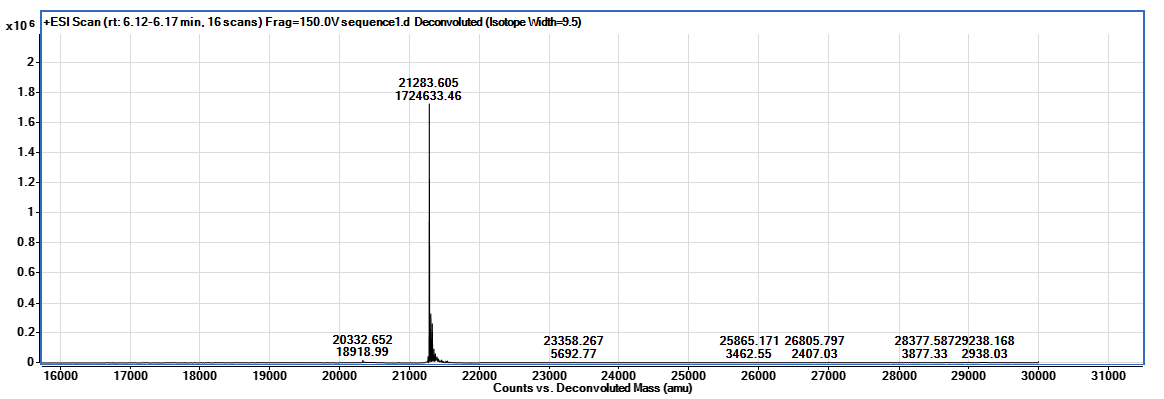Enterovirus D68 3C protease small scale expression and purification protocol
Korvus Wang, michael fairhead, Eleanor Williams
Disclaimer
Research was supported in part by NIAID of the U.S National Institutes of Health under award number U19AI171399. The content is solely the responsibility of the authors and does not necessarily represent the official views of the National Institutes of Health.
Abstract
This protocol details the expression and purification of enterovirus D68 3C protease construct bearing a C-terminal His-tag at small scale (<6L).
Attachments
Steps
Abbreviations
CV - column volume, total volume of resin in a column
IMAC - immobilised metal affinity chromatography
D68EV3C - Enterovirus D68 3C protease
Plasmid Transformation
Transform the D68EV3C construct (Addgene plasmid #204817) into BL21(DE3) and store a glycerol stock of this at -80°C
Protein expression
Scrape off some of the glycerol stock with a sterile loop and use this to inoculate a 50 mL falcon tube containing 10mL of LB supplemented with 50ug/mL kanamycin. Grow the starter culture at 37°C 4h 0m 0s with 200 rpm shaking.
Use the 10mL starter culture to inoculate 1L Sample(see Materials) supplemented with 50ug/mL kanamycin in a baffled flask. 250rpm
When the OD600 reaches approximately 4.0, lower the temperature and shaker speed to 200rpm and incubate 24h 0m 0s
Harvest the cells by centrifugation at 5000x g,4°C. Discard supernatant and store pellet at -80°C .
Protein Purifcation
Lyse cell pellet
Thaw and resuspend the pellet in ~7mL of lysis buffer per g of pellet. Stir gently with a magnetic stir bar at Room temperature for 0h 30m 0s to allow lysozyme, benzonase and Triton X-100 to start breaking down cell components.
Store the homogenised lysate at -80°C and then thaw in a room temperature water bath to further lyse the cells, freeze-thaw.
Centrifuge the lysed cells 38000x g,4°C to remove insoluble cell debris, and collect the supernatant 4°C
Perform IMAC to extract target protein from the lysed cell mixture
Dispense 10mL Nickle affinity resin (Ni Sepharose 6 FF, Cytiva) into a gravity flow column.
Wash the resin first with ~ 20CV distilled water to remove the storage solution and then ~ 20CV binding buffer to equilibrate
Pour the clarified supernatant over the equilibrated resin and allow to flow though. This will allow the His-tagged target protein to bind onto the Ni ions in the resin.
Retain the flow through separately for SDS-PAGE analysis.
Wash the column with 10CV of wash buffer twice. Allow wash buffer to pass through completely between washes. This is to remove non-specific, weak binding of contaminant proteins from the resin for a cleaner elution.
Collect washes separately for SDS-PAGE analysis.
Elute the protein with 1.5CV of elution buffer.
Repeat step 7.5 a further 2 times, collecting a total of 3 separate elution fractions. This is to ensure maximum retrieval of protein from the resin.
Measured the A280 values of the elution fractions to estimate the protein content
For example:
E1: A280=5.69
E2: A280=10.1
E3: A280=4.23
Run SDS-PAGE of all samples from total lysis supernatant to final elution. Stain gel with Coomasssie Blue and determine which fractions contain the target protein by finding the band corresponding to the target molecular weight, 21.3 kDa.

Purify sample further by size exclusion chromatography.
Pool and concentration all elution fractions to a final volume of under 5mL using a 10 kDa MWCO centrifugal concentrator
Remove any solid aggregates from the sample by centrifugation at 17200x g,4°C , then immediately draw up the supernatant with a 5mL syringe and a blunt-tip fill needle, taking care not to disturb the pellet.
Using an AKTA Pure FPLC system or equivalent:
Inject the sample onto a 5mL sample loop.
Run the sample down Sepax SRT SEC-100 gel filtration column at 7.5mL/min in gel filtration buffer, collecting 1mL fractions in 96 well deep-well blocks.
The column should be pre-equilibrated in SEC buffer.
Run the peak SEC fractions on SDS PAGE to assess purity.
For example:


Take the fractions that contain the cleanest target protein and concentrate to21mg/mL using a 10 kDa MWCO centrifugal concentrator
Take 1µL of the final sample for SDS-PAGE, and another for mass spectroscopy.

Aliquot into appropriate volumes for future usage to minimise freeze/thaw cycles. Flash-freeze in liquid nitrogen, and store at -80°C until required.
For example:
The final yield from processing 2 L of cells was 128 mg of pure D68 EV 3C protease

